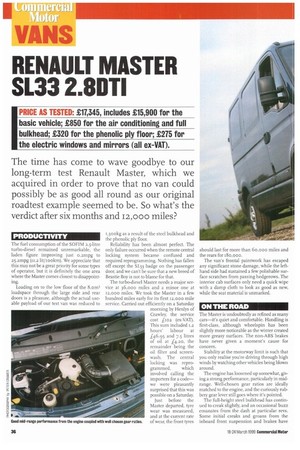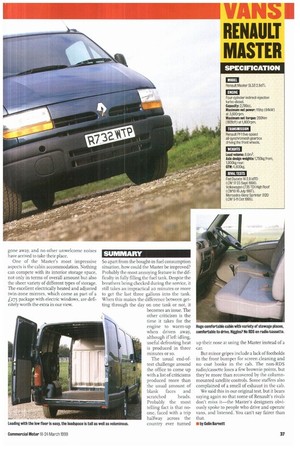RENAULT MASTER SL33 2.80TI
Page 38

Page 39

If you've noticed an error in this article please click here to report it so we can fix it.
IPRICE AS TESTED: £17,345, includes £15,900 for the basic vehicle; £850 for the air conditioning and full bulkhead; £320 for the phenolic ply floor; £275 for the electric windows and mirrors (all ex-VAT).
PRODUCTIVITY
The fuel consumption of the SOFIM 2.5-litre turbo-diesel remained unremarkable, the laden figure improving just o.zmpg to 25.2mpg (11.2 lit/rookm). We appreciate that this may not be a great priority for some types of operator, but it is definitely the one area where the Master comes closest to disappointing.
Loading on to the low floor of the 8.oml loadspace through the large side and rear doors is a pleasure, although the actual useable payload of our test van was reduced to 1,300kg as a result of the steel bulkhead and the phenolic ply floor.
Reliability has been almost perfect. The only failure occurred when the remote central locking system became confused and required reprogramming. Nothing has fallen off except the SL33 badge on the passenger door, and we can't be sure that a new breed of Beastie Boy is not to blame for that.
The turbo-diesel Master needs a major service at 36,000 miles and a minor one at 12,000 miles, We took the Master in a few hundred miles early for its first 12,000 mile service. Carried out efficiently on a Saturday morning by Henlys of Crawley, the service cost £102 (ex-VAT). This sum included 1.2 hours' labour at £46.95 and 7.5 litres of oil at £4.20, the remainder being the oil filter and screenwash. The central locking was repro
grammed, which involved calling the importers for a code— we were pleasantly surprised that this was possible on a Saturday.
just before the Master departed, tyre wear was measured, and at the current rate of wear, the front tyres should last for more than 6 o,000 miles and the rears for 18o,000.
The van's frontal paintwork has escaped any significant stone damage, while the lefthand side had sustained a few polishable surface scratches from passing hedgerows. The interior cab surfaces only need a quick wipe with a damp cloth to look as good as new, while the seat material is unmarked.
ON THE ROAD
The Master is undoubtedly as refined as many cars—it's quiet and comfortable. Handling is first-class, although wheelspin has been slightly more noticeable as the winter created more greasy surfaces. The non-ABS brakes have never given a moment's cause for concern.
Stability at the motorway limit is such that you only realise you're driving through high winds by watching other vehicles being blown around.
The engine has loosened up somewhat, giving a strong performance, particularly in midrange. Well-chosen gear ratios are ideally matched to the engine, and the curiously rubbery gear lever still goes where it's pointed.
The full-height steel bulkhead has continued to creak slightly, and an occasional buzz emanates from the dash at particular revs. Some initial creaks and groans from the inboard front suspension and brakes have
gone away, and no other unwelcome noises have arrived to take their place.
One of the Master's most impressive aspects is the cabin accommodation. Nothing can compete with its interior storage space, not only in terms of overall amount but also the sheer variety of different types of storage. The excellent electrically heated and adjusted twin-zone mirrors, which come as part of a 1275 package with electric windows, are definitely worth the extra in our view. So apart from the bought-in fuel consumption situation, how could the Master be improved? Probably the most annoying feature is the difficulty in fully filling the fuel tank. Despite the breathers being checked during the service, it still takes an impractical 20 minutes or more to get the last three gallons into the tank. When this makes the difference between getting through the day on one tank or not, it becomes an issue. The other criticism is the time it takes for the engine to warm-up when driven away, although if left idling, useful defrosting heat is produced in three minutes or so.
The usual end-oftest challenge around the office to come up with a list of criticisms produced more than the usual amount of blank faces and
scratched heads. Probably the most telling fact is that noone, faced with a trip halfway across the country ever turned up their nose at using the Master instead of a car.
But minor gripes include a lack of footholds in the front bumper for screen cleaning and no coat hooks in the cab. The non-RD S radio/cassette loses a few brownie points, but they're more than recovered by the columnmounted satellite controls. Some staffers also complained of a smell of exhaust in the cab.
We said this in our original test, but it bears saying again so that some of Renault's rivals don't miss it—the Master's designers obviously spoke to people who drive and operate vans, and listened. You can't say fairer than that.




















































































































